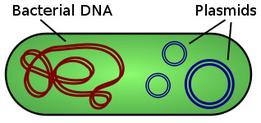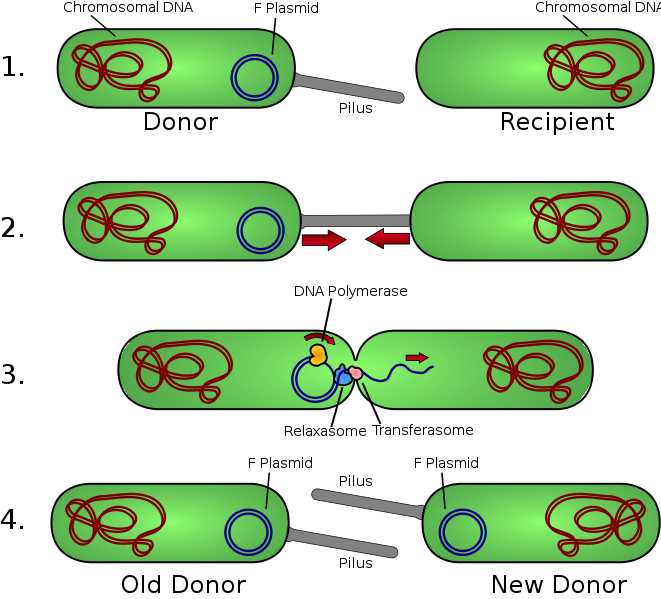 | ||||
Bacterial Genetics
Plasmid DNA & Conjugation Gene Transfer
CLASS NOTES from Science Prof Online
Both the bacterial nucleoid and bacterial plasmids are circular molecules of DNA - genetic information. Plasmids are, however, much smaller than the bacterial chromosome, usually only containing a few genes.
Unlike the bacterial chromosome, plasmid traits are not normally required for the cell to function, but do help a bacterium survive and cause disease. Not all bacteria have plasmids,
Article Summary: A plasmid is a molecule of DNA, independent of the bacterial nucleoid chromosome, which often has "bonus DNA" with instructions for weapons of infection.
Bacterial Plasmid DNA & Conugation
In order to transfer a plasmid, the bacterium with the plasmid must have the genetic instructions required to construct a sex pilus—a prokaryotic cell extension that can hook up to a recipient bacterium, connecting the two bacteria and physically pulling them towards each other. The genetic information for making a pilus is called the F (fertility) factor. The donor bacterium, which is considered F+, makes a copy of the plasmid and extends the pilus to the recipient (the F- cell). The newly copied plasmid is then transferred to the recipient. In the end, both the donor and the recipient bacteria have a copy.
Although plasmids are most often exchanged between closely related bacteria, some plasmids can be shared by very dissimilar microbes. A donor and a recipient do not always need to be of the same species in order to share a plasmid. Plasmids can even be shared between different cell types, such as when a bacterium (prokaryotic cell) shares a plasmid with a eukaryotic microbe, such as yeast.
Types of Bacterial Plasmids
There are many different types of plasmids, in addition to F factors mentioned above. Plasmids called R factors carry genes for antibiotic resistance, or resistance to chemicals that, without the plasmid, would be toxic to the bacterium. MRSA (methicillin-resistant Staphylococcus aureus) is a disease-causing type of bacteria that, due to the acquisition of R factors, is resistant to a wide range of antibiotics, and is able to cause dangerous, difficult-to-treat infections.
Bacteriocin factors carry genes for making proteins that kill other bacteria that do not have this factor, reducing competition for the bacteria that have it. Other plasmids, called virulence factors have genes that help bacteria cause disease, such as the productions exotoxins that make those infected with the bacterium ill, or genes for adhesins, that allow the bacterium to adhere to and infect certain host cell types.
Sources and Helpful Bacterial Genetics Links
- Bacterial Conjugation Animation animation and quiz from McGraw-Hill
- Conjugation: Transfer of the F Plasmid animation and quiz from McGraw Hill
- Microbial Genetics Lecture Main Page from the Virtual Microbiology Classroom.
- Bacterial Chromosome Compaction from McGraw-Hill.
- Cell Structure interactive tutorial from Wiley interactive tutorial from Wiley
- Bauman, R. (2014) Microbiology with Diseases by Taxonomy 4th ed., Pearson Benjamin Cummings.
- Haney Carr, Janice (2008) "Superbug, super-fast evolution": CDC monograph on Understanding Evolution website.
- Tortora, G., Funke, B., Case, C. (2010) Microbiology, an Introduction. Benjamin Cummings
 | ||||
You have free access to a large collection of materials used in a college-level introductory microbiology course. The Virtual Microbiology Classroom provides a wide range of free educational resources including PowerPoint Lectures, Study Guides, Review Questions and Practice Test Questions.
SCIENCE PHOTOS
Page last updated: 5/2014
 | ||||||
SPO VIRTUAL CLASSROOMS
 | ||||||
SPO is a FREE science education website. Donations are key in helping us provide this resource with fewer ads.
Please help!
(This donation link uses PayPal on a secure connection.)
Conjugation: Transferring Plasmids
Conjugation is a type of horizontal gene transfer, a way for organisms to share genetic information with each other. Horizontal gene transfer can be contrasted with vertical gene transfer - the transmission of genetic traits from generation to generation, parent to offspring. Conjugation is how a bacterium can share the information on a plasmid with its neighbors.
SCIENCE VIDEOS
but those that do can share these advantageous molecules with other bacteria in a process called conjugation.






